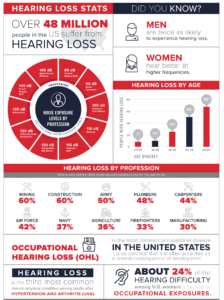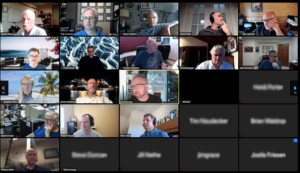Why Professional Communication Matters

Communication at work shapes every part of our careers, but many employees face a hidden obstacle that has a big impact on their job success – hearing loss. Research shows that workers who don’t treat their hearing loss make up to $30,000 less per year compared to coworkers with normal hearing.
But the real cost goes way beyond just lost income. From missing out on chances in video calls to problems in open offices, trouble hearing creates big roadblocks to success at work. What’s more many companies still don’t know how to help employees dealing with these issues.
This guide takes a deep look at hearing loss costs that often go unnoticed in workplaces, with a focus on communication hurdles and ways to solve them. We’ll check out current numbers new tech, and real-world tips to create workplaces where everyone feels welcome helping both workers and companies.
1. Getting to Know Hearing Loss at Work

Hearing loss at work is becoming a bigger issue across many fields. Numbers show that about 12% of all workers struggle to hear, while another 8% deal with ringing in their ears. Also around 20% of workers exposed to loud noises and tested have hearing problems that get in the way of their day-to-day tasks.
Some industries have a higher risk of hearing problems. Mining and construction jobs often lead to more workers with hearing loss. Also, while just 4% of healthcare workers deal with dangerous noise levels, a whopping 74% of them say they don’t wear hearing protection.
These issues have an impact on jobs too. 54% of deaf people have jobs, compared to 70% of people who can hear. In the Middle East more than 11 million out of 350 million people have serious hearing loss.
a. Common workplace communication challenges

Employees with hearing loss face many challenges in their daily work interactions. Open-plan offices often create a noisy environment, with keyboard clicks and general workplace sounds mixing with conversations. This background noise makes even simple face-to-face talks tough to follow.

Working from home comes with its own set of problems. Online meetings can be tricky:
- Poor sound quality and internet lags
- Hard to read lips on video calls
- Getting tired from listening during back-to-back virtual meetings

Group talks create more problems when chats move between many people. Workers often hold back during these talks. They worry they might talk over others or miss key points. Also sudden meetings cause extra stress because it’s hard to find interpreters .
Work communication’s social side takes a hit too. Many deaf workers feel left out when coworkers don’t know how to talk with non-hearing folks. This goes beyond formal meetings – everyday office chats and work social events become limited changing team bonds and work relationships.
2. How Untreated Hearing Loss Affects Finances

Hearing loss left untreated has a financial impact that goes beyond just communication problems. Studies show it has a big economic effect on workers and society as a whole.
a. Direct income loss statistics

Workers who don’t treat their hearing loss earn much less than others – up to $ 30,000 less per year. In fact, people with hearing loss make about 25% less money. Their average pay is $ 23,000, while people with normal hearing earn $ 31,000. This pay gap leads to a total yearly income loss of $175 billion because of underemployment.
b. Career advancement limitations

Career growth hits big roadblocks because of poor communication at work. People with bad hearing problems have a 15.6% unemployment rate – twice as high as everyone else at 7.8%. Also, those with hearing issues often quit work , which means they earn less money over their lifetime and struggle.
c. Healthcare costs

Money troubles don’t stop there. They spill over into health expenses too. When hearing loss goes untreated, it has an impact on:
- Total healthcare costs over 10 years jumping up by 46%, which adds up to $22,000 per person
- Hospital stays increasing by 47%
- Risk of going back to the hospital within 30 days, going up by 44%
- Outpatient visits, with 52 more compared to those who hear well
d. Lost productivity metrics

Productivity losses have a big effect on companies’ bottom lines. So, studies reveal that hearing loss makes up 72% of all workplace-related expenses. The estimated lifetime productivity losses hit 96,871 PALYs for men and 38,690 PALYs for women in the workforce. This means when put into money terms, these productivity losses add up to $4 billion for male workers and $1.5 billion for female workers.
Still, the right treatment shows good results. Using hearing aids cuts down income loss risk by 90-100% for mild hearing loss and 65-77% for moderate to severe cases. This shows that tackling hearing loss through expert communication help and proper treatment can reduce these money-related impacts.
3. Communication Barriers in Modern Workplaces

Today’s workplaces create unique professional communication challenges for employees who can’t hear well building barriers that have an impact on both productivity and workplace relationships.
a. Remote meeting challenges

Online meetings bring complex obstacles for workers with hearing impairments. Research indicates that video conferencing fatigue hits harder for those who struggle to hear because they need to concentrate on every word. On top of that low-quality audio, buffering problems, and noise from other participants’ surroundings add extra strain.
Even with cutting-edge tech online meetings still present specific hurdles:
- Sound clarity problems from different internet speeds
- Trouble reading lips through video feeds
- More mental tiredness from long virtual sessions
b. Open office environments

Open-plan workspaces have an impact on collaboration often creating big communication hurdles. Studies show that employees with hearing problems in open offices have higher stress hormone levels and perform worse when they need to remember word meanings.
Background noise causes ongoing problems, because hearing aids make all sounds louder at once. Even simple chats become hard work when mixed with keyboard noises general office talk, and machine sounds. Research finds that noise levels of 47–50 dBA can mess up communication for people with hearing issues, unless the office has good sound control.
c. Group discussions

Group chats at work can be tricky and shake up how people interact. Studies reveal that in talks, we take turns in split seconds, which tests folks with hearing problems. Workers often find it hard to:
How many people are in the chat group plays a big role in how well everyone gets it. Research points out that groups should stick to 6-10 people to talk best. Another option is to set up seats in a circle or horseshoe. This helps everyone see each other, which is key for those who need to read lips.
Sound-blocking tech and smart seating plans can tackle these issues. At the same time good lighting and clear views let people pick up on visual hints during chats. These changes help make group talks more open to everyone while keeping things pro.
4. Tech Fixes for Smoother Talking

New tech has a big impact on how workers with hearing loss talk to each other at work. Things like better hearing aids and new digital tools help break down many barriers to talking at work.
a. New stuff in hearing aids

Today’s hearing aids have cool new features made just for work. AI in hearing aids makes work talk easier to hear. These smart devices learn as they go and change on their own in noisy places like busy offices or meeting rooms.
Bluetooth is a big deal. It lets hearing aids hook up straight to phones and other work stuff without extra gadgets. Plus, telehealth lets people fix their hearing aids from home, so they don’t have to go to the office as much.
For example rechargeable hearing aids now use lithium-ion batteries giving users convenience and reliability during long workdays. Keep in mind, these devices have built-in activity sensors and tinnitus relief sounds offering full support for workplace needs.
b. Digital communication tools
 Given the changing workplace needs several digital solutions work with hearing aids to boost communication effectiveness:
Given the changing workplace needs several digital solutions work with hearing aids to boost communication effectiveness:
- Real-time transcription apps such as Google Live Transcribe and AVA turn speech into text during meetings and talks
- Video conferencing platforms with captions help remote work communication
- Personal amplifiers and remote microphone systems aid one-on-one conversations across room distances
Assistive listening systems send sound straight from public address systems to hearing devices making big meetings easier to follow. Another option for workplaces is to set up induction loop systems. These create magnetic signals that hearing aids can detect through telecoil settings.
Text telephone services and relay systems help bridge gaps in communication. They change typed messages into speech and the other way around. These tools are useful for phone calls and online meetings where clear sound might be tricky.
Smart hearing protection devices now gather data on how often people wear personal protection and how loud the workplace is. This helps companies spot and fix potential communication issues. Also, these devices tell workers right away when noise levels are harmful. This encourages workers to take safety steps while still talking at work.
5. Building a Supportive Work Environment

Building a workplace that welcomes everyone needs people at all levels of the company to pitch in and help employees who have trouble hearing. Studies reveal that more than half of workers who don’t hear well are reluctant to talk about their hearing problems with their bosses, which shows why companies need to take the lead in offering support.
a. Role of managers

Managers have a big impact on professional communication and inclusion. Research shows that 27% of operational managers don’t know much about hearing loss, which highlights the need to improve leadership training.
The main thing managers should do is have regular one-on-ones with hearing-impaired employees to talk about:
- Flexible work options for hearing doctor appointments
- How they prefer to communicate and what they need
- Ways to support their performance
- Reviews of workplace adjustments
In fact, managers need to create a work environment where staff feel okay talking about their hearing loss. So it’s key to give chances for employees to share this information throughout their time at the company, from when they’re hired to their regular performance reviews.
b. Coworker education

While tech solutions are important, help from coworkers is one of the most crucial types of support at work. Still many workers say their teammates often don’t know how to talk with people who have hearing problems.
Training about deafness is key to create an inclusive workplace. This training teaches staff:
- Different kinds of hearing loss
- Barriers to communication
- Ways to improve interactions
- How to use interpreters when needed
Also, companies should think about starting buddy programs to build supportive relationships between employees. These programs help create natural support networks in teams while encouraging inclusive practices.
c. Workplace adjustments

The People with Disabilities Act requires employers to make reasonable changes unless doing so causes too much hardship. So, organizations should focus on making both physical and communication-based adjustments.
Modifications to physical workspaces include:
- Putting up acoustic panels and soft furnishings
- Adding rubber caps to chair and table legs
- Placing employees where they can see their coworkers
- Making sure there’s good lighting to read lips
- Setting up visual alert systems for emergencies
Ways to help with communication might involve providing:
- People who can interpret sign language for big meetings
- People who can turn speech into text for detailed records
- People who can take electronic notes for key sessions
- Services that relay video
- Phone headsets that work well with hearing aids
Some employees also do better with flexible schedules or quiet places to work. The government’s Access to Work program often helps pay for pricier workplace changes, which makes it easier for companies to offer full support.
To wrap up, workplace assessments play a key role in pinpointing specific obstacles and solutions for each employee. These evaluations, which you can get through government programs or specialized providers, make sure the accommodations fit the unique needs of each person. This approach helps improve professional communication and job success.
Conclusion:

Hearing loss creates big hurdles to success at work impacting both individual careers and how well organizations perform. Research shows that when hearing loss goes untreated, it leads to major income gaps, which can reach up to $ 30,000 per worker each year. But the good news is that proper support through cutting-edge technology and workplace adjustments helps close these gaps .
Companies that focus on inclusive communication see clear benefits. In particular, workers who use hearing aids cut their risk of losing income by 90-100% for mild cases and 65-77% for moderate to severe ones. These figures show how tackling hearing issues head-on helps both staff and employers.
Success needs buy-in from everyone in the workplace – leaders must grasp the challenges of hearing loss, team members need to learn about inclusive communication, and firms should bring in the right tech solutions. By doing all this together, businesses create spaces where every worker can give their all and grow in their career.
Good communication at work is key for career growth and job satisfaction. Companies that get this and step up to support staff with hearing loss set themselves up for better results while building inclusive workplaces
